Strong Response to "Experiment!" Funding Initiative
630 applications have been submitted in the second round of calls. From the many outstanding proposals, the Foundation selected 19 exceptionally innovative projects in the areas of the natural and life sciences and engineering.
The Volkswagen Foundation started the "
Experiment!" funding initiative in 2013 with the aim of providing support for exceptionally daring new research projects with uncertain outcomes – and quickly found out it had hit on an important gap on the funding landscape: The response was remarkable, with no less than 704 applications in the first round of calls, of which 13 were selected for funding. Interest in the second round was similarly high, with 630 applications. In the second round the Foundation will finance 19 projects it has selected for their particularly innovative research approaches. Here is a brief outline two of these projects:

Ultrasonic reflectors modeled along the lines of echo-reflecting flower petals
Nowadays, driverless vehicles, robots and modern automobiles all incorporate sonar systems as more-or-less standard equipment. These systems usually make use of ultrasonic signals to measure the distance to other objects. Observations of bats, which also use ultrasonic signals for orientation, lead scientists to believe the technology may have further potential. Up to now, though, there is a lack of suitable landmarks or signals to aid vehicle orientation in all environments. This is where the "Experiment!" project devised by Dr. Ralph Simon and Dr. Stefan J. Rupitsch at the Department for Sensor Technology of the University of Erlangen-Nurnberg comes in. The two researchers want to develop bio-inspired ultrasonic reflectors as navigation aids for robots and driverless vehicles.
Spider silk to glue nerve cells in the brain
Spider-silk threads are extremely elastic, tear resistant, heat resistant, and antibacterial. On top of this, they are not rejected by the human body and are biologically degradable. All this makes them the ideal material for an unique medical application proposed by Prof. Dr. Manuela Gernert from the University of Veterinary Medicine in Hanover and Prof. Dr. Christine Radtke from the Medical University of Hanover: They want to use spider silk to protect epilepsy sufferers from seizures.
Currently researchers around the world are testing a new technique for treating epilepsy patients in rodents: This involves transplanting the progenitor cells of so-called inhibitory interneurons into hyperexcitable regions of the brain. These cells interrupt the transmission of stimuli to neighboring cells, thus relieving cramps and either avoiding epileptic attacks altogether or mitigating their effect. The applicatory problem: The transplanted cells are highly mobile and have to be fixed in one position until they become integrated in the neural network. Gernert and Radtke have come up with an unusual idea of how to halt the cells in the right part of the brain: The nerve cells adhere extraordinarily well to spider silk. If the scientists can succeed in introducing spider silk into the affected region of the brain it may be possible to use it to glue down the interneurons. In order to achieve this, Gernert and Radtke need to develop a suitable micro-surgical method. Apart from transplantation studies in the area of epilepsy, the method may subsequently also find application in the prevention of other neurological diseases involving cell transplants.

Hartplastik statt Gußeisen: Der Motor der Zukunft Eine aktuelle Herausforderung für die moderne Gesellschaft besteht darin, den Treibstoffverbrauch und die CO2-Emissionen von Fahrzeugen zu reduzieren. Dafür arbeitet die Automobilindustrie u.a. an der Verringerung des Fahrzeuggewichts, insbesondere von Karosseriebauteilen. Doch auch beim Motor wäre eine Gewichtsreduktion sinnvoll: Motoren bestehen heute zumeist aus Gusseisen und bringen im PKW zwischen hundert und dreihundert Kilo, im LKW auch mal über eine Tonne auf die Waage. Hier kommt die "Experiment!"-Idee von Prof. Dr.-Ing. Wolfgang Tillmann von der Technischen Universität Dortmund ins Spiel: Er plant eine komplett neue, leichte Motorenkonstruktion – aus Hartplastik oder Glasfaser- bzw. Carbonfaser-Kunststoff-Verbundstoffen. Zu diesem Zweck möchte der Wissenschaftler zunächst eine neue Methode entwickeln, um schmale Röhren, über die die Verbrennungshitze in das Kühlwasser ableitgeleitet werden kann, mit einer dünnen, extrem glatten und verschleißarmen Oberfläche zu produzieren. Daraus wird der Kühlzylinder aufgebaut, der zudem eine äußere Ummantelung zur thermischen Abschirmung erhält. In Kombination mit Originalbauteilen will Tillmann daraus schließlich einen einfachen Motorblock konstruieren. Weitere Informationen zu allen 19 geförderten Projekten finden Sie über die
Projekt-Personen-Suche der VolkswagenStiftung. Beispiele für Projekte aus der ersten Runde können Sie im Bericht
Rückenwind für Kreative: Erstes Forum Experiment! nachlesen.

